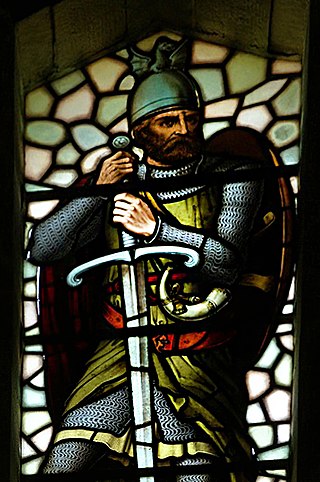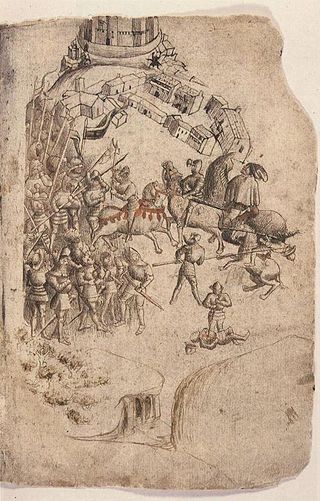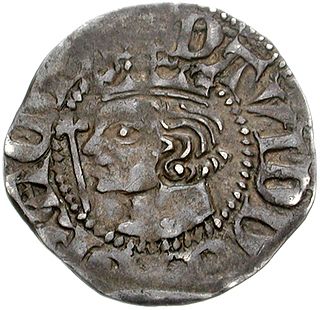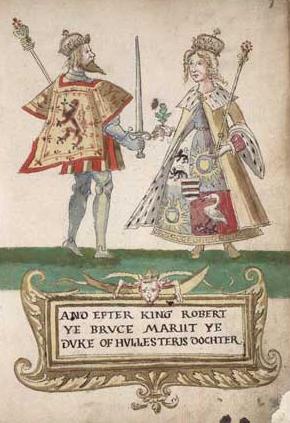
Braveheart is a 1995 American epic historical war drama film directed and produced by Mel Gibson, who also portrays its central character, Sir William Wallace, a late-13th-century Scottish warrior who led the Scots in the First War of Scottish Independence against King Edward I of England. The film also stars Sophie Marceau, Patrick McGoohan and Catherine McCormack. The story is inspired by Blind Harry's 15th-century epic poem The Actes and Deidis of the Illustre and Vallyeant Campioun Schir William Wallace and was adapted for the screen by Randall Wallace.

The Declaration of Arbroath is the name usually given to a letter, dated 6 April 1320 at Arbroath, written by Scottish barons and addressed to Pope John XXII. It constituted King Robert I's response to his excommunication for disobeying the pope's demand in 1317 for a truce in the First War of Scottish Independence. The letter asserted the antiquity of the independence of the Kingdom of Scotland, denouncing English attempts to subjugate it.

Robert I, popularly known as Robert the Bruce, was King of Scots from 1306 to his death in 1329. Robert led Scotland during the First War of Scottish Independence against England. He fought successfully during his reign to restore Scotland to an independent kingdom and is regarded in Scotland as a national hero.

Sir William Wallace was a Scottish knight who became one of the main leaders during the First War of Scottish Independence.

The Wars of Scottish Independence were a series of military campaigns fought between the Kingdom of Scotland and the Kingdom of England in the late 13th and 14th centuries.

John Balliol or John de Balliol, known derisively as Toom Tabard, was King of Scots from 1292 to 1296. Little is known of his early life. After the death of Margaret, Maid of Norway, Scotland entered an interregnum during which several competitors for the Crown of Scotland put forward claims. Balliol was chosen from among them as the new King of Scotland by a group of selected noblemen headed by King Edward I of England.

The Battle of Bannockburn was fought on 23–24 June 1314, between the army of Robert the Bruce, King of Scots, and the army of King Edward II of England, during the First War of Scottish Independence. It was a decisive victory for Robert Bruce and formed a major turning point in the war, which ended 14 years later with the de jure restoration of Scottish independence under the Treaty of Edinburgh–Northampton. For this reason, the Battle of Bannockburn is widely considered a landmark moment in Scottish history.

Robert II was King of Scots from 1371 to his death in 1390. The son of Walter Stewart, 6th High Steward of Scotland, and Marjorie, daughter of King Robert the Bruce, he was the first monarch of the House of Stewart. Upon the death of his uncle David II, Robert succeeded to the throne.

David II was King of Scotland from 1329 until his death in 1371. Upon the death of his father, Robert the Bruce, David succeeded to the throne at the age of five and was crowned at Scone in November 1331, becoming the first Scottish monarch to be anointed at his coronation. During his childhood, David was governed by a series of guardians, and Edward III of England sought to take advantage of David's minority by supporting an invasion of Scotland by Edward Balliol, beginning the Second War of Scottish Independence. Following the English victory at the Battle of Halidon Hill in 1333, King David, Queen Joan and the rump of his government were evacuated to France, where he remained in exile until it was safe for him to return to Scotland in 1341.
The Treaty of Edinburgh–Northampton was a peace treaty signed in 1328 between the Kingdoms of England and Scotland.

Elizabeth de Burgh was the second wife and the only queen consort of Robert the Bruce. Elizabeth was born sometime around 1289, probably in what is now County Down or County Antrim in Ulster, the northern province in Ireland. She was the daughter of one of the most powerful Norman nobles in the Lordship of Ireland at that time, Richard Óg de Burgh, the 2nd Earl of Ulster, a member of the noble dynasty, the House of Burgh and a close friend and ally to King Edward I of England.

Marjorie Bruce or Marjorie de Brus was the eldest daughter of Robert the Bruce, King of Scots, and the only child born of his first marriage with Isabella of Mar.
Carruthers, sometimes Caruthers, is a Scottish surname and clan, originating from the lands of Carruthers in Dumfriesshire.

Clan Bruce is a Lowlands Scottish clan. It was a royal house in the 14th century, producing two kings of Scotland, and a disputed High King of Ireland, Edward Bruce.

Edward Balliol or Edward de Balliol was a claimant to the Scottish throne during the Second War of Scottish Independence. With English help, he ruled parts of the kingdom from 1332 to 1356.

Sir William Oliphant, Lord of Aberdalgie and Dupplin, was a Scottish magnate, knight and leader during the Wars of Scottish Independence.
The Battle of Kinghorn was fought on 6 August 1332 at Wester Kinghorn, Fife, Scotland. An invading seaborne force of 1,500 men was commanded by Edward Balliol and Henry Beaumont, Earl of Buchan. A Scottish army, possibly 4,000 strong, commanded by Duncan, Earl of Fife, and Robert Bruce, Lord of Liddesdale was defeated with heavy loss. Balliol was the son of King John Balliol and was attempting to make good his claim to be the rightful king of Scotland. He hoped that many of the Scots would desert to him.
Sir William Oliphant, was a Scottish knight and Governor of Stirling Castle during the Wars of Scottish Independence. He switched loyalties to the English and died in a Scottish prison.
Bob Carruthers is a Scottish filmmaker, author and broadcaster.

Outlaw King is a 2018 historical action drama film about 14th-century Scottish king Robert the Bruce during the Scottish Wars of Independence. The film largely takes place during the 3-year period from 1304, when Bruce decides to rebel against the rule of Edward I over Scotland, up to 1307 Battle of Loudoun Hill. Outlaw King was co-written, produced, and directed by David Mackenzie.














